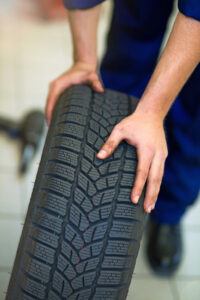Tips for Safe Driving and Insurance Savings
Winter is a beautiful but challenging season for drivers. Cold temperatures, snow, ice, and freezing rain can make road conditions treacherous. To ensure your safety and minimize the risk of accidents during the winter months, it’s crucial to winterize your vehicle. In this article, we’ll discuss vehicle maintenance tips for safe winter driving and explain how regular maintenance can impact your auto insurance rates.
Vehicle Maintenance Tips for Safe Winter Driving
1.  Check Your Tires
Check Your Tires
Your tires are your vehicle’s point of contact with the road, and they play a critical role in ensuring safe winter driving. Here’s what to do:
- Tire Pressure: Cold temperatures can cause tire pressure to drop, so check your tire pressure regularly and inflate them to the recommended levels as indicated in your vehicle’s owner’s manual.
- Tire Tread: Inspect your tire tread depth. Tires with inadequate tread are more likely to lose traction on slippery roads. Consider switching to winter tires for enhanced grip.
- Chains or Snow Tires: If you live in an area with heavy snowfall, consider using snow chains or dedicated snow tires for added traction.
2. Test Your Battery
Cold weather can strain your vehicle’s battery, making it more likely to fail. Before winter sets in, have your battery tested by a mechanic. If it’s nearing the end of its life, consider replacing it to prevent getting stranded in the cold.
3. Inspect Your Brakes
Your brakes are crucial for safe driving year-round, but they become even more critical in winter conditions. Have your brakes inspected by a professional to ensure they’re in good working order.
4. Change Your Oil
Using the right type of oil for winter conditions is essential. Switch to a lower-viscosity oil that flows more easily in cold weather. Regular oil changes are also important for engine health.
5. Check Your Antifreeze
Ensure your vehicle’s cooling system has the right concentration of antifreeze to prevent freezing. A 50/50 mix of antifreeze and water is generally recommended.
6. Maintain Your Lights and Wipers
Visibility is crucial during winter driving. Make sure all your vehicle’s lights are functioning correctly, including headlights, taillights, brake lights, and turn signals. Replace any burnt-out bulbs promptly. Additionally, replace worn wiper blades to ensure clear visibility in rain and snow.
7. Keep Fluid Levels in Check
Check fluid levels regularly, including windshield washer fluid, power steering fluid, and transmission fluid. Make sure they’re at the appropriate levels to prevent problems during winter driving.
8. Carry an Emergency Kit
Prepare an emergency kit for your vehicle that includes essentials like a blanket, flashlight, extra warm clothing, non-perishable food, water, a first-aid kit, and basic tools. You may also want to include items like a shovel, ice scraper, and sand or kitty litter for added traction.
How Regular Maintenance Can Impact Auto Insurance Rates
Auto insurance companies consider various factors when calculating your insurance premiums, and your vehicle’s condition and maintenance can play a role. Here’s how regular maintenance can impact your auto insurance rates:
1. Safety Features and Maintenance Discounts
Many insurance providers offer discounts for vehicles equipped with safety features like anti-lock brakes, airbags, and electronic stability control. Regular vehicle maintenance, including brake checks and tire rotations, can help ensure these safety features are in optimal working condition, potentially making you eligible for discounts.
2. Preventing Accidents
Well-maintained vehicles are less likely to experience mechanical failures that could lead to accidents. For example, regular brake inspections and replacements reduce the risk of brake failure. Fewer accidents mean a lower likelihood of filing claims, which can help you maintain lower insurance premiums.
3. Reducing Claims Frequency
A well-maintained vehicle is less likely to experience breakdowns, which can lead to towing and repair claims. Fewer claims mean you’re less likely to be considered a high-risk driver, which can help keep your premiums lower.
4. Increasing Resale Value
Regular maintenance, such as oil changes and brake pad replacements, can help preserve the value of your vehicle. If you ever need to file a comprehensive or collision claim, a well-maintained vehicle may have a higher claim payout, helping you repair or replace your vehicle more effectively.
5. Compliance with Policy Requirements
Some auto insurance policies may include requirements for maintaining your vehicle in good working condition. Failing to meet these requirements can result in policy cancellations or non-renewals. Regular maintenance ensures you meet these obligations, preventing disruptions in coverage.
Winterizing your vehicle is a crucial step to ensure safe and reliable driving during the cold and challenging winter months. Regular maintenance not only protects your safety on the road but can also impact your auto insurance rates positively. By keeping your vehicle in top condition, you reduce the risk of accidents, claims, and breakdowns, which can help you maintain lower insurance premiums.
Remember that good maintenance practices go hand in hand with safe driving habits. Be cautious when driving in winter weather, reduce your speed, and allow for extra stopping distance. By combining regular maintenance with responsible driving, you can enjoy a safe and cost-effective winter driving experience. Get a free quote on your insurance (NY State) by calling our team at 607-547-2951.


 As winter approaches, homeowners often focus on holiday preparations and staying warm, but it’s equally important to prepare your home for the challenges that the cold season brings. Winterizing your home not only ensures your comfort but also helps prevent common winter-related insurance claims. In this article, we’ll discuss the importance of winter home maintenance and provide tips on insulating pipes, checking heating systems, and maintaining fireplaces to keep your home safe and cozy.
As winter approaches, homeowners often focus on holiday preparations and staying warm, but it’s equally important to prepare your home for the challenges that the cold season brings. Winterizing your home not only ensures your comfort but also helps prevent common winter-related insurance claims. In this article, we’ll discuss the importance of winter home maintenance and provide tips on insulating pipes, checking heating systems, and maintaining fireplaces to keep your home safe and cozy. Hurricanes are powerful and unpredictable natural disasters that can wreak havoc on homes and communities, even in our region in upstate NY. As a homeowner, being prepared for hurricane season is essential to safeguard your property and loved ones. In this article, we’ll share some helpful tips on preparing your home for hurricane season and explain why having the right insurance coverage is crucial during these catastrophic events.
Hurricanes are powerful and unpredictable natural disasters that can wreak havoc on homes and communities, even in our region in upstate NY. As a homeowner, being prepared for hurricane season is essential to safeguard your property and loved ones. In this article, we’ll share some helpful tips on preparing your home for hurricane season and explain why having the right insurance coverage is crucial during these catastrophic events. As schools reopen, drivers need to be extra cautious when driving near schools and school buses. Here are some essential safety tips to keep in mind:
As schools reopen, drivers need to be extra cautious when driving near schools and school buses. Here are some essential safety tips to keep in mind: When you’re a young parent, life is a whirlwind of diapers, first steps, and sleepless nights. Amid the chaos and joy of raising a family, one important consideration that often gets overlooked is life insurance. It’s easy to assume that life insurance is something you can put off until later in life, but the reality is that it’s essential, especially for young families. In this article, we’ll explore why life insurance is crucial for young families and provide guidance on choosing the right policy to protect your loved ones today and tomorrow.
When you’re a young parent, life is a whirlwind of diapers, first steps, and sleepless nights. Amid the chaos and joy of raising a family, one important consideration that often gets overlooked is life insurance. It’s easy to assume that life insurance is something you can put off until later in life, but the reality is that it’s essential, especially for young families. In this article, we’ll explore why life insurance is crucial for young families and provide guidance on choosing the right policy to protect your loved ones today and tomorrow. At first glance, spring cleaning and home insurance might seem unrelated. However, a well-maintained and organized home can significantly impact your home insurance premiums and coverage. Here’s how:
At first glance, spring cleaning and home insurance might seem unrelated. However, a well-maintained and organized home can significantly impact your home insurance premiums and coverage. Here’s how: It’s called Life Insurance, but it could just as easily be labeled Love Insurance. Buying life insurance is really an expression of love. It lets loved ones know that you care so much that you’ve made plans to provide for their well-being…even after you’re gone.
It’s called Life Insurance, but it could just as easily be labeled Love Insurance. Buying life insurance is really an expression of love. It lets loved ones know that you care so much that you’ve made plans to provide for their well-being…even after you’re gone. As the calendar turns a new page, many individuals and businesses take the opportunity to set resolutions and goals for the year ahead. Among the priorities that often get overlooked is the review and update of insurance policies. However, this crucial step can have a significant impact on financial security, providing peace of mind in the face of life’s uncertainties. In this article, we’ll delve into the importance of reviewing and updating insurance policies at the beginning of the year, and some proactive steps you can take to make sure your coverage is aligned properly with your current circumstances.
As the calendar turns a new page, many individuals and businesses take the opportunity to set resolutions and goals for the year ahead. Among the priorities that often get overlooked is the review and update of insurance policies. However, this crucial step can have a significant impact on financial security, providing peace of mind in the face of life’s uncertainties. In this article, we’ll delve into the importance of reviewing and updating insurance policies at the beginning of the year, and some proactive steps you can take to make sure your coverage is aligned properly with your current circumstances. Understanding the Importance of Small Business Insurance
Understanding the Importance of Small Business Insurance
 Motorcycles offer a thrilling and liberating way to travel the open road, but they also come with unique risks that demand heightened attention to safety and insurance considerations. In this comprehensive guide, we’ll explore motorcycle safety tips to keep riders safe and delve into the importance of motorcycle insurance, highlighting how it differs from auto insurance.
Motorcycles offer a thrilling and liberating way to travel the open road, but they also come with unique risks that demand heightened attention to safety and insurance considerations. In this comprehensive guide, we’ll explore motorcycle safety tips to keep riders safe and delve into the importance of motorcycle insurance, highlighting how it differs from auto insurance.



 Explore Part-Time Employment:
Explore Part-Time Employment:



